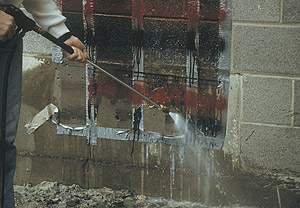
...continued from previous page
Stripping Coatings
from Masonry
Stripping paint from the porous surface of masonry block starts off pretty much like stripping paint from any other surface. It's the follow-up that's a real drag.
by David Thompson
Another of the active ingredients used by some of the new-generation strippers is soy methyl ester, derived from soybeans.
Franmar Chemicals makes SOY-Gel, a stripper that combines soy methyl ester with NMP.
“Soy methyl ester, which is the primary component in SOY-Gel, would strip paint on its own, but it would take a couple days,” says Jason Davenport, Franmar’s marketing director. “NMP strips paint quickly, but also evaporates quickly. What we do is combine the two, and we get some very nice properties.”
SOY-Gel removes paints, urethanes and enamels, and it doesn’t burn your skin or give off harsh odors.
The newest of the new generation of strippers uses a technology known by the trade name SARA, for Selective Adhesion Release Agents. It’s based on benzyl alcohol and water, which create a chemical reaction in which oxygen is released once the stripper penetrates the substrate, breaking its bond with the coating. SARA strippers work on a variety of coatings, including two-component epoxies and polyurethanes, latexes, epoxy esters and alkyds.
SARA is patented by Napier Environmental Technologies, and sold as Napier’s RemovALL line, as well as ICI Paints’ HydroStrip and PPG’s DuraPrep lines.
“SARAs are actually a combination of chemicals that, if you put them on paint individually, won’t strip anything. But when you blend them together in the right way, they strip paint,” says Todd Cotrell, Napier’s industrial business manager.
When SARA strippers were first introduced in the 1990s, they didn’t brush or roll well on vertical surfaces. But a new brush-and-roll version has since been released, making it a suitable stripper for masonry block.
While the new generation of strippers has taken over the marketplace, you can still walk into any paint store in America and find methylene chloride, if you’re up for a blast back to the carcinogenic past. The original take-it-all-off stripper, methylene chloride dominated the market for decades, and it’s still considered the fastest-working and cheapest stripper out there.
It’s excellent at removing all types of varnish, enamel, lacquer, vinyls, phenolics, acrylics, urethane and vinyl tiles and linoleum with mastics, as well as finishes from porcelain. It evaporates in an instant, and requires repeated applications to remove multiple coats. It’s also notoriously toxic, and poses many well-known health and environmental problems.
With the advent of so many effective, biodegradable, less-toxic strippers, methylene chloride has fallen out offavor with contractors, and manufacturers steer customers away from it.
“We only recommend methylene chloride if there’s something you want to get off real fast, or if you have a real heavy-duty epoxy, with 60, 70, 80 percent solids in there.” says Hy Dubin, whose Peel-Away II contains the chemical.
Samax Enterprises, which in 1936 introduced Rock-Miracle, the original methylene chloride stripper, now has a safer, healthier alternative, Upta-6. It’s a NMP gel stripper that, like SOY-gel and similar products, encapsulates stripped coatings, making it particularly good for the removal of lead paint. Gels take care of containment. They are also particularly good on masonry because it’s easy to get them into all of the pores, either with a bristle brush or airless sprayer.
But methylene chloride still has its place among the newer, more appealing strippers.
“If you’re looking for the least expensive and fastest working stripper, methylene chloride is the way to go,” says Charles Wolfson, vice-present of sales for Samax. “But if people are nearby, you don’t want problems with odor or you don’t want guys wearing safety suits, then we don’t recommend it.”

|

